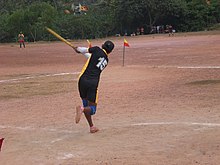
Sri Lanka has several traditional games and sports, many of which are played during the Aluth Avurudda festival. [1] [2] Some of these games are similar to other traditional South Asian games.

Sri Lanka has several traditional games and sports, many of which are played during the Aluth Avurudda festival. [1] [2] Some of these games are similar to other traditional South Asian games.
In Ankeliya, two horns are attached to a strong tree, and then a rope is thrown across both horns. Two teams tug at the opposite ends of the rope until one of the horns breaks off. [3] [2]
Batta is a form of hopscotch in which players must hop through various boxes while moving a stone forward through the boxes. Stepping on the ground with a disallowed foot, stepping on the lines between the boxes, or moving the stone into a disallowed area causes a player to lose. [4]

Gudu keliya is a variation of gilli-danda in which one player attempts to knock a small stick on the ground up into the air by hitting it with a longer stick held in the hand, and then tries to hit the small stick as far as possible. [5] Opponents can catch the small stick before it touches the ground to make the hitter lose. [3] [2]
Kotta Pora is a pillow-fighting game in which two opponents sit on top of a pole which is balanced off the ground. Both players must keep one hand behind their back and, using a pillow held with the other hand, attempt to knock the opponent off the pole. [6] [3] [7]
Players must attempt to break water-filled pots that are suspended off the ground with a stick while blindfolded. [6] [3] [7]
In this game, the players of two teams throw coconuts at each other, and use their own coconuts to block the coconuts thrown at them. As the game progresses, some of the coconuts eventually break, and by the end of the game, the team with the most intact coconuts wins. [8]
Kili Thadthu (related to the Tamil game of Killithattu) is a game in which two teams of six players compete in periods of seven minutes, with the teams alternating offense and defense in each period. To score, the attacking team's players must make it across the entire field without being tagged by the defensive players, who stand on lines drawn horizontally across the field. [6]


Angampora is a Sinhalese martial art that combines combat techniques, self-defense, sport, exercise, and meditation. [12] [13] A key component of angampora is the namesake angam, which incorporates hand-to-hand fighting, and illangam, involving the use of indigenous weapons such as the ethunu kaduwa, staves, knives and swords. [14] [15] Another component known as maya angam, which uses spells and incantations for combat, is also said to have existed. [16] Angampora's distinct feature lies in the use of pressure point attacks to inflict pain or permanently paralyze the opponent. Fighters usually make use of both striking and grappling techniques, and fight until the opponent is caught in a submission lock that they cannot escape. Usage of weapons is discretionary. Perimeters of fighting are defined in advance, and in some of the cases is a pit. [16] [17]
A number of paintings related to angampora are found at Buddhist temples in Sri Lanka. These include Embekka Devalaya, Gadaladeniya Rajamaha Viharaya, Temple of the Tooth, Saman Devalaya (Ratnapura) and Lankathilaka Rajamaha Viharaya. [18] [19]
Peralikatuma is a two-player abstract strategy board game from Sri Lanka (formerly called Ceylon). It is a game related to draughts (checkers) and alquerque as players hop over one another's pieces when capturing them. The game was documented by Henry Parker in Ancient Ceylon: An Account of the Aborigines and of Part of the Early Civilisation (1909) with the name perali kotuwa or the war enclosure. [20] Parker mentions that it is also played in India. It closely resembles another game from Sri Lanka called Kotu Ellima. The two games use the same board which consist of a standard alquerque board but with four triangular boards attach to its four sides. The only difference between the two games is in the number of pieces. In peralikatuma, each player has 23 pieces. In Kotu Ellima, each player has 24 pieces.
The game is also spelled as perali kotuma.Hat diviyan keliya.